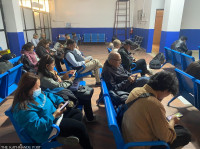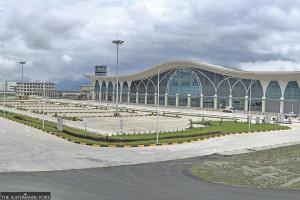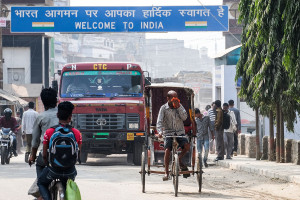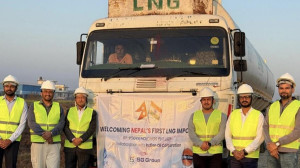Money
Turmeric: Women love what monkeys hate
Women’s cooperative in Chitwan builds a new enterprise cultivating the spice.
Ramesh Kumar Paudel
For years, Laxmi Lama of Kholaghari in Chitwan struggled to grow beans and other vegetables on her small plot. Monkeys repeatedly raided the fields, leaving her with no choice but to abandon cultivation. Many of her neighbours faced the same fate.
But things have changed.
“After hearing that monkeys do not touch turmeric, I began cultivating it,” said Lama, who has now joined a women’s cooperative to expand her new enterprise.
With improved seeds and training this year, her crop looks promising. “In the beginning, I didn’t know much, so the harvest was modest. But this time I’ve had training. I learned how to apply fertiliser and select good seeds. The crop looks good. We’ll dig up the turmeric in February–March, and I expect a much better harvest,” she said.
Similar stories are emerging across Chitwan and neighbouring Tanahun district.
From the fields to the marketplace, women are active everywhere. Turmeric, a staple in every kitchen, is now being grown, processed, ground, packaged and marketed by women who once struggled with crop losses due to wildlife.
In Chitwan, a women-led cooperative has expanded turmeric farming and established a processing facility, helping its members turn cultivation into an enterprise.
Last Sunday, women affiliated with the Safal Social Entrepreneur Women’s Cooperative Limited in Jugedi, Bharatpur Metropolitan City–29, gathered at Bakulahar Chowk in Ratnanagar.
Carrying half-kilogram packets of turmeric, they visited local hotels, restaurants, snack shops and shopping malls, sharing their story and urging people to buy their product. Many did.
Lama was among them. “Last year, I planted turmeric on three katthas. I harvested about five quintals and earned Rs13,000,” she said. While the income wasn’t great, it ended years of leaving her land uncultivated because monkeys destroyed other crops.
Across the Trishuli river in Basantapur of Tanahun district, turmeric cultivation has taken root as well.
Thakur Kumari Kafle of Basantapur planted turmeric on seven katthas this year. “There’s a forest nearby. Monkeys, wild boars, porcupines and deer destroyed whatever crop we planted. But they don’t eat turmeric,” she said. Turmeric farming has now spread across the settlement, with 29 katthas under cultivation this year.
Kafle expects more land to be used next season.
The shift toward turmeric cultivation is being promoted by the Women’s Group Coordination Committee, which organises rural women into groups, strengthens them and helps them form cooperatives.
The committee has brought four women’s cooperatives in Chitwan and one in Devghat, Tanahun, into the turmeric initiative. Most members are from rural and hilly areas rather than urban centres.
Bhateri village, a part of the Bharatpur Metropolitan City, lies in Chitwan’s hilly belt. Similarly, members of the Tin Dobhan Social Entrepreneur Women’s Cooperative Limited—comprising women from wards 10 and 11 of Kalika Municipality—have also taken to turmeric farming.
Wards 10 and 11 include Siddhi, a hilly region inhabited largely by the Chepang Indigenous community. Women from Laganshil Cooperative in Kalika-8 and Chandibhanjyang Cooperative in Ichchhakamana Rural Municipality-6 are also cultivating turmeric. Kafle is affiliated with the Chakrabarti Cooperative in Devghat-5 of Tanahun.
“Altogether, 714 women from four cooperatives in Chitwan and one in Tanahun—cooperatives run entirely by women—are now involved in turmeric cultivation,” said Sita Paudel, coordinator of the Women’s Group Coordination Committee.
Farmers grow turmeric on plots ranging from three to six katthas, while some groups collectively cultivate up to 18 katthas. Altogether, about 25 bighas are under turmeric cultivation.
The Safal Cooperative has established a processing plant in Bhateri. It buys raw turmeric from farmers at Rs35 per kilogram. “We wash it, slice it, dry it, grind it and package it right here,” said Bimala Tamang, the cooperative manager. The products are sold under the “Chandra Surya” brand.
Safal launched the processing unit last year with a grant from its partner organisation, Heifer. “Our turmeric is sold not only in Chitwan but also in Pokhara and Kathmandu. Once people try it, they come back for more,” said board member Dilkumari Gurung.
“We grow turmeric organically using manure and earthworm compost. Once someone tastes this turmeric, they don’t look for any other,” she added.
Last fiscal year, the cooperative purchased turmeric worth Rs1.46 million and sold the spice worth Rs1.99 million, according to cooperative accountant Pooja Tamang.
Safal packages its turmeric in 200-gram and 500-gram packets.
For farmers like Lama, turmeric has brought a measure of financial security. When she sold raw turmeric for Rs13,000 last year, about half was profit. With more experience, she hopes to further reduce costs.
Agricultural technician Lilaman Praja Chepang, who supports farmers through the cooperative, said turmeric is best planted from February to March in the hills and in May in the Tarai. The crop matures in seven to nine months.
“Previously, women grew only a few kilos for household use. Now they are planting commercially and turning it into a business. They are learning and improving,” she said.




 16.12°C Kathmandu
16.12°C Kathmandu1.jpg)













